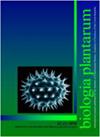白卫矛叶片再生快速高效繁殖系统
IF 0.9
4区 生物学
Q4 PLANT SCIENCES
引用次数: 1
摘要
植物组织培养快速繁殖对大规模生产、分子遗传学研究和育种具有重要意义。目前,需要一种快速高效的白芷组织培养方案。为了开发该物种的繁殖系统,我们建立了一个新的叶片再生系统。在添加0.5mg dm-3 6-苄基氨基嘌呤(6-BA)和0.5mg dm3α-萘乙酸(NAA)的Murashige和Skoog(MS)培养基上诱导愈伤组织形成,在红色辐射下21 d内诱导率几乎达到100%,20d内诱导率接近100%。当不定芽转移到含有1/2MS、2.0mg dm-3吲哚-3-丁酸(IBA)和0.05mg dm-3 NAA的生根培养基中时,不定根在20d内形成,为有效的大规模繁殖提供了有益的参考,可以作为未来基因工程的一种使能技术。本文章由计算机程序翻译,如有差异,请以英文原文为准。
Rapid and efficient leaf regeneration propagation system for Euonymus bungeanus
Rapid propagation of plants by tissue culture is of great significance for large-scale production, molecular genetics research, and breeding. Currently, a rapid and high-efficient tissue culture protocol for Euonymus bungeanus is needed. To develop a propagation system for this species, we established a new regeneration system from leaves. Callus formation was induced on Murashige and Skoog (MS) medium supplemented with 0.5 mg dm-3 6-benzylaminopurine (6-BA) and 0.5 mg dm-3 α-naphthalene acetic acid (NAA) and the induction rate almost reached 100 % under red radiation within 21 d. The medium for proliferation of adventitious buds comprised of MS medium with 1.0 mg dm-3 6-BA and 0.5 mg dm-3 NAA, and the induction rate within 20 d nearly reached 100 %. When, the adventitious buds were transferred to the rooting medium containing 1/2MS, 2.0 mg dm-3 indole-3-butyric acid (IBA), and 0.05 mg dm-3 NAA, adventitious root formation was achieved within 20 d. Collectively, the rapid and high-efficient regeneration system from E. bungeanus leaves was established, providing useful references for effective mass propagation and it could serve as an enabling technology for future genetic engineering.
求助全文
通过发布文献求助,成功后即可免费获取论文全文。
去求助
来源期刊

Biologia Plantarum
生物-植物科学
CiteScore
2.80
自引率
0.00%
发文量
28
审稿时长
3.3 months
期刊介绍:
BIOLOGIA PLANTARUM is an international journal for experimental botany. It publishes original scientific papers and brief communications, reviews on specialized topics, and book reviews in plant physiology, plant biochemistry and biophysics, physiological anatomy, ecophysiology, genetics, molecular biology, cell biology, evolution, and pathophysiology. All papers should contribute substantially to the current level of plant science and combine originality with a potential general interest. The journal focuses on model and crop plants, as well as on under-investigated species.
 求助内容:
求助内容: 应助结果提醒方式:
应助结果提醒方式:


